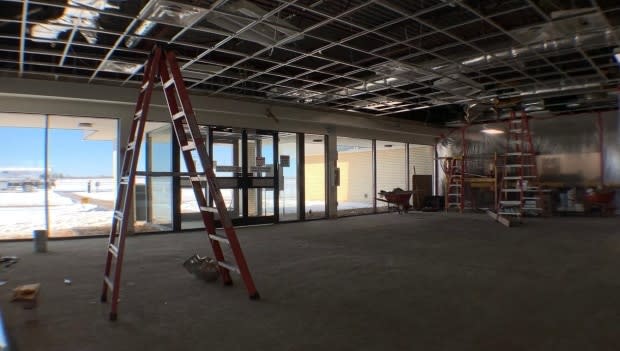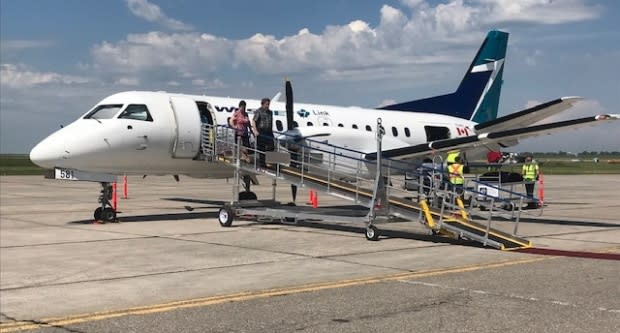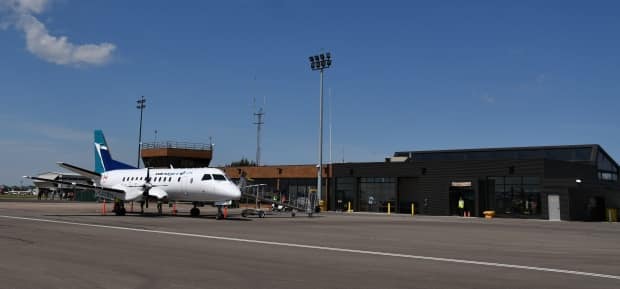Alberta's smaller airports look to take off with expanded passenger service
The only flying Graham Ingham does these days is in a flight simulator at one of the two flight schools located at Red Deer Regional Airport, the facility he's been running as chief executive officer since 2016.
The former airline captain, with 14,000 hours of domestic and international flight experience, says it's been six years since he's flown.
There are other priorities on his radar.
He's trying to navigate the return of scheduled passenger service to his small airport, there's about 100 hectares of airport land he wants to lease for development and there's the ongoing plan to refurbish an existing hangar as a new air terminal building.
He believes he is close to making the airport financially sustainable — another priority since the facility takes in $750,000 in subsidies a year from the City of Red Deer and Red Deer County. The airport is currently running a $500,000 deficit.
"It's pretty much just hang on for the time being and work toward creating new business development opportunities, air service, as well as land development," he said.
Red Deer Regional Airport is located southwest of Red Deer, near the hamlet of Springbrook. It was used as an air training base for Allied forces during the Second World War and is a former Royal Canadian Air Force training base in the 1950s and '60s. It's had several names over the years, including Canadian Forces Base Penhold, RCAF Station Penhold and No. 36 Service Flying Training School.

Ingham says the airport's location is ideal: sandwiched between Calgary and Edmonton and the three million people who call those cities home.
The challenge, though, is convincing people — and airlines — that it would be more convenient and cheaper to fly out of Red Deer than Alberta's two big cities. Ingham says there is a market for air travel in the Red Deer region. He says roughly 750,000 trips were taken by people in central Alberta who drove to either Calgary or Edmonton to fly out of those cities, generating nearly $250 million in airline revenues.
Ingham says his best hope for regular passenger service may be with either Enerjet or Canada Jetlines — two low-cost, no-frill startups that have both delayed their launch dates.

He says because of the two flight schools, charter traffic and other activities, there were 76,000 aircraft movements last year, a number that's continued to climb despite Air Canada's decision last year to ground its three daily flights to Calgary with the 19-seater Beechcraft 1900D.
When the Air Canada service launched in 2014, about 24,000 passengers boarded the flights. However, the numbers dwindled to just 10,000 last year.
Ingham says Air Canada's decision wasn't unexpected and the flights made up less than 2 per cent of aircraft movements at the airport, but still he says the decision stung.
"Obviously the loss of business and the services is pretty disappointing," he said.
He says they have signed a letter of intent with an unnamed low-cost carrier, but work must progress on a new air terminal building and apron.
It's a dilemma that prompts the question: If you build it, will they come?
"It's very difficult to convince anybody, including myself, that spending $12 million to expand a terminal in anticipation of somebody entering the market. That's a tough sell," he said.
Increased traffic at Lethbridge, Medicine Hat
There's been more takeoffs and landings at airports in Lethbridge and Medicine Hat in 2018 as well. Lethbridge hit 30,000 movements for the first time since 2008, while Medicine Hat climbed past 22,000 last year, the highest number in five years. Both cities have regular, scheduled passenger service from WestJet and Air Canada.
"In Lethbridge alone, we have seen nearly a double per cent increase in total traffic since the launch of our service," said Morgan Bell, a spokesperson for WestJet.

WestJet Link was introduced in both cities in June 2018. The airline did not provide specific passenger numbers for either city.
Air Canada used larger, 50-seat aircraft out of both cities this past summer and will continue with those aircraft again next February.
The mayor of Lethbridge says the move to larger aircraft has eased some travellers' concerns.
"Now people are a little more confident because these are larger planes. They were nervous before, some people didn't like the idea of flying on a 19-seater," said Chris Spearman.
Passenger traffic in Lethbridge reached 87,300 last year, a 52 per cent increase over 2017.
In Medicine Hat, passenger traffic reached 48,200 on Air Canada's and WestJet's seven daily flights to Calgary last year.
Spearman says improvements to the 40-year-old air terminal building are planned in the short-term to improve the passenger experience.

The airport's master plan describes the terminal building as "generally insufficient" for Air Canada and WestJet passengers flying on 34-, 50- and 78-seat aircraft.
Along with the terminal expansion and upgrades, the runway, taxiways and aprons need rehabilitation, the parking lot needs to be expanded and the electrical system to be upgraded. The cost for all of those improvements is estimated at $14 million.
Spearman says the other priority is the commercial development of nearly 400 hectares of airport land.
The City of Medicine Hat owns and operates the Medicine Hat Regional Airport and there's been a significant increase in passenger volumes since WestJet introduced daily flights to Calgary last year.

"We started courting WestJet 11 years ago, it took 10 years," said Mayor Ted Clugston.
"It's exceeded our expectations."
"Since WestJet has come here, our airport traffic has pretty much doubled, and it hasn't been at the expense of Air Canada," said Clugston.
He says $17 million was spent on improvements to the terminal building and runway in the past three years.
New development, solar farm
Back at the Red Deer Regional Airport, Ingham is hoping for a turnaround in 2020. And he says there's good reason to be optimistic.
A Toronto-based developer and other partners are planning to start developing approximately 80 hectares of land for commercial and industrial aviation use. A large-scale solar farm is also planned west of the main runway.
Ingham says about two-thirds of their revenues come from land leases, so getting those sites up and running could help pay for air terminal building upgrades and the possible return of scheduled passenger service.

Tucana Aviation is set to take over the main terminal as a fixed-base operator, providing aircraft handling services under a new five-year contract.
And it was recently announced the airport will transition to a controlled facility with NAV Canada air traffic control services — a move that could lead to a new control tower.
"We are well on our way to being one of the most successful regional airports in Canada," he said.
Bryan Labby is an enterprise reporter with CBC Calgary. If you have a good story idea or tip, you can reach him at bryan.labby@cbc.ca or on Twitter at @CBCBryan.

